Reinforcement in construction is necessary, first of all, for reinforcing concrete. Such a connection allows you to transfer the forces of a compressive and tensile nature to the reinforcing bars. This is simply necessary when building a foundation, since concrete has little resistance to such loads.
|
fittings |
It is not correct to reinforce with connections from straight rods, this weakens the structure, which can lead to various unpleasant consequences, for example, to delamination of the foundation.
Therefore, bending of reinforcement is necessary both for creating corner bundles of bent rods and for creating various elements, for example, paws, hooks, etc.
Fiberglass rods bend only at the enterprises for their release. If you try to bend it on your own, then it will simply burst. Metal reinforcement is bent strictly mechanically; no sharp corners should be allowed at the place of bending.
Until now, several methods are popular that are not desirable for bending rods. This:
- Filed angle grinder bend
- Warming up the bend high temperature blowtorch, etc.
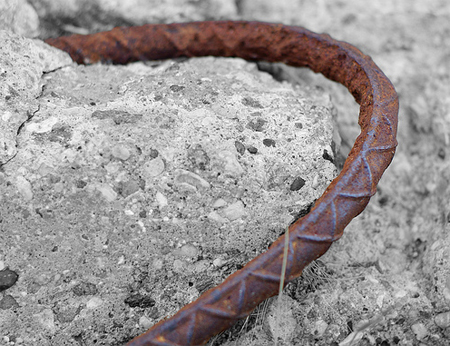
Bent reinforcement in concrete.
Any type of metal rods bends only cold without any cuts or other violations of the integrity of the rod. Moreover, each type can be bent to a certain angle, after which it will lose strength. For example, type A3 reinforcement can be bent at an angle of no more than 90 degrees without loss of strength. When bent 180 degrees, strength is reduced by at least 10%.
All rebar bending equipment can be divided into several categories
th- Manual
- Having a mechanical drive.
- hydraulic
Driven equipment works as follows
A thrust roller is fixed on the rack, a disk is mounted on the vertical shaft, on which the fingers (bending and central) are fixed. Between them lay the rods for bending. When the disk begins to rotate in a horizontal plane, the laid rod abuts against the roller and bends under the influence of the bending pin. The bending finger moves from the outside of the rod.
Bending machines, depending on the rods, are also divided into equipment:
- For bending with rods from 3 to 20 mm.
- For bending rods from 20 to 40 mm.
- For bending rods from 40 to 90 mm.
- For bending rods from 3 to 90 mm.
Manual bending equipment has many types, it can even be portable. Usually installed on a workbench for more convenient use. Much cheaper than other options and quite easy to use. The tool is suitable for small amounts of work.
Before buying a tool, you must know the scope of work, the timing and diameter of the rods to be bent. In addition, it must be remembered that the outer part of the reinforcement is more subject to tensile loads and the inner part to compression.
If you choose the wrong equipment or use it not according to the instructions, you can easily ruin both the fittings and the machine. Therefore, before use, the structure must be set up correctly and, when used, the reinforcing bar must be correctly clamped in it.

One of the fittings for bending reinforcement
When special care and precision are not required, thenyou can bend the rods even with your own hands. If you have strong hands and a rod with a diameter of 8 mm is not a problem.
Two steel pipes will facilitate the process and improve the quality of the bend. The longer the pipes, the larger the diameter of the rod can be bent.
The process itself is quite simple:
- The rod is inserted into the first, fixing pipe to the place of the bend.
- The second pipe will be used as a lever. it is put on the other end of the reinforcement and is led in the right direction.
- The armature is bent.
Modification is also possible when both pipes are firmly buried or driven into the ground. The rod is wound between the pipes and bent into the desired position.
An example of a homemade rebar bending machine
Manual rebar bending machine:
Rebar bending machine is a necessary device used during construction as well as industrial work.
With its help, in the future, it is realistic to manufacture both reinforced concrete and metal structures.
There are cases when you can do it on your own, but most often the thickness of the products is so large that it is possible to achieve bending only with the help of special devices.
The modified rebar bending machine allows not only to give sheets and other materials the desired shape, but also to cut them.
Also, many devices make it possible to make rings, mounting clamps and parts, loops, which are used in installation and at a construction site, from wire, pipes or other raw materials.
Despite the complexity of the design, the machine can be designed and assembled by hand. To do this, you need a prepared drawing, tools and knowledge of the principles of operation of the device.
For domestic purposes, a home-made manual bending machine for reinforcement is used, first of all, when building a foundation.
It is almost impossible to make a reliable foundation without reinforcing parts, so the question arises - how to make a frame, how to bend the existing reinforcement?
Of course, today on the market you can find huge selection professional equipment, but the price for it can be very high.
Such devices are bought for industrial purposes, the arrangement of workshops, construction companies. For your personal purposes, a do-it-yourself design is suitable.
If we talk about technological standards, then the machine for bending reinforcement must have three shafts.
One of them is persistent (holds the rods at a certain angle and fixes them), the second serves to bend the material around the main shaft - the third. It is also called central.
Depending on the type of construction, a mechanical one is also distinguished.
The latter has found wide application in everyday life, because it is compact in size and relatively low cost, and, due to its simplicity, everyone can work on it.
There are also hydraulic or pneumatic devices. So, a hydraulic rebar bending machine can bend material at an angle of up to 180 degrees, ensuring no breakage.
When designing with your own hands, you must not only stick to your project, but also Special attention pay attention to the quality of fasteners (after all, the load on parts can be very high), and take care of the organization of protection.
A slipping rod can cause serious injury.
Therefore, often on the simplest bending machines for fittings you can find plexiglass protection, which you can easily do yourself.
Also, if you have experience in assembling machine tools, you can provide your design with speed switching to control work.
Some models are equipped with a foot panel, which allows you to easily change the direction of reinforcement feed.
How to make a home machine?
In order to cope with a manual bending machine for fittings with your own hands, you must first prepare a number of tools.
If you are fond of assembly and construction, then finding such parts and the right equipment will not be difficult.
First of all, you need electric welding. For a device that can even cope with sheets, you will need a reliable base, a punch, clamps and a clamp.
1 - bending disk mounted on a vertical shaft; 2 - finger; 3 - a hole for a finger; 4 - stops; 5 - reinforcing bar; 6 - axial stop
The punch can still be assembled from metal corners. Suitable for assembling and cutting channels.
The base is cut out precisely thanks to the latter.
Here the fifth or sixth number of the channel model is suitable. But the length should be chosen small - no more than 50 centimeters.
The rebar bending machine will consist of a lever, a punch, a clamp and a main part on which pipes and rods or sheets will be placed.
First, on the basis of the selected place, an axis for clamps is made - it will be more convenient to navigate along it.
However, remember that the clamps should cut 6 millimeters less in length than the blanks made under the base.
They also keep at a distance of several centimeters from the ends - without such an indent it will be impossible to properly distribute the load.
For the lever, a wire is suitable, the diameter of which should be no more than 15 millimeters.
The base is bent in the form of the letter "P", and it is welded using a welding machine to one of the stable corners. There should be an indent of about 5 millimeters from the edge.
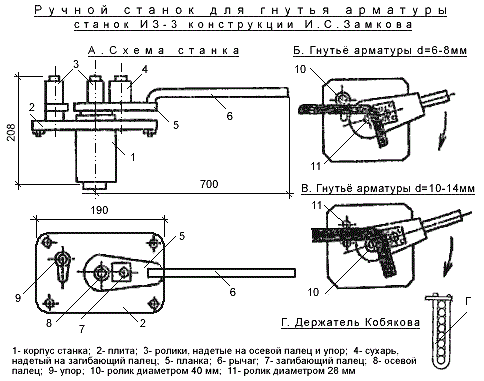
In order to properly weld all the parts and check the corners, evenness of the structure, docking, you can first use a vice, and already carry out welding work on them.
Thus, it will turn out to make a preliminary frame, which can always be redone.
Also, where possible, it is better to use bolts instead of welding. So you can always reassemble or disassemble your design, supplement it with details.
If, nevertheless, preference is given to welding work, then first it is necessary to carry out a test bending procedure. If all stages go well, then you can weld the parts together.
How to add cutting elements?
In addition to the fact that you can give different shapes to products on a home-made device, it’s really possible to make a rebar cutting machine that will combine both functions: cutting and bending.
Of course, it is much more difficult to design it with your own hands, but it also has more applications. The easiest option is to make a carved disc on the base using a grinder.
A rebar cutting machine can be made in any room. Its design can be either collapsible or solid.
In the first case, such a device can be easily dismantled and assembled in a new place.
Speaking constructively, in addition to the shafts for bending, the machine for cutting reinforcement should consist of an engine, a cutting blade or disk, and the surface itself where the blade will be fixed.
Knowing the principle of operation, you can easily make your own changes to the feed mode.
The power must be determined in advance, before the rebar cutting machine is assembled.
Professional devices are characterized by high power - about 2000 watts.
Despite the fact that smaller indicators can be chosen for domestic purposes, one should not forget that metal remains metal in any situation, and a large load is needed to cut it.
Another characteristic directly related to engine power is gear selection.
Most often it is a belt or friction friction transmission. In this case, the engagement can be chain, worm or gear, it all depends on what materials you have at hand.
Belts give silent operation, however, the likelihood that such a design will slip is very high, so it is better not to choose this type of transmission here.
A homemade rebar cutting machine is also equipped with a vise that does not allow the material to leave the cutting axis.

As a knife at home, either a carbide disc or an abrasive wheel is most often chosen. The type of device depends on the feed of the tool.
It can be front, bottom or pendulum feed.
The assembly principle is very similar to the bending design. So, a rebar cutting machine is being made from a frame, which in turn is assembled from metal corners.
It is necessary to attach a channel to the resulting base, which will play the role of a guide axis, and all other parts are attached to it.
Only the engine needs an additional reinforced pipe.
The bearings, which are needed to support and drive the mechanism, are attached to the upper frame, and the shaft and motor are attached with bolts.
In addition, where the disk will be fixed (also with the help of bolts), you need to take care of the protective case, because when it comes into contact with metal, a spark will occur.
Work on the machine is best checked at idle and using soft metals. Later, if everything works fine, you can check the installation in full force.
The main thing is that the distance from the bending shaft and the disk is at least 40 centimeters.
The question of how it is possible to bend reinforcement not only in production, but also at home, is of interest to many of those who are independently engaged in construction on their personal plot. The relevance of this issue is due to the fact that the reliability and durability of the erected buildings and concrete structures for any purpose largely depend on the correct implementation of this process.
Why is it necessary to bend reinforcement and how best to do it
As you know, concrete structures do not tolerate bending loads, under the influence of which they begin to collapse. To avoid such negative consequences, concrete structures are strengthened with frames made of steel bars, and more recently, composite reinforcement has also been used for the same purposes. Without a reinforcing frame, it is almost impossible to make a reliable foundation for any structure, as well as concrete structures that experience mechanical loads during operation.
The weakest points in any reinforcing cage are the joints of the bars, which is especially important for corner joints, the creation of which by crossing straight reinforcing bars is a serious violation of technology.

Corner sections of the reinforcing cage, formed in such an incorrect way, significantly weaken the concrete structure and can lead to its delamination. That is why for such connections it is necessary to bend and lay reinforcement in such a way that an overlap of at least 80 cm is formed on each bar adjacent to it. Bent reinforcing elements are used not only to create frames for the foundation, they are also used as connecting elements that are operated under the influence of tensile loads (hooks for various purposes, paws, etc.).
Only experts know how to bend the reinforcement in such a way that it does not lose its original strength characteristics. At the same time, it is important to keep in mind that only metal reinforcement, but not composite materials, can be bent with your own hands (information on how to cut fiberglass reinforcement can be found at the end of the article).
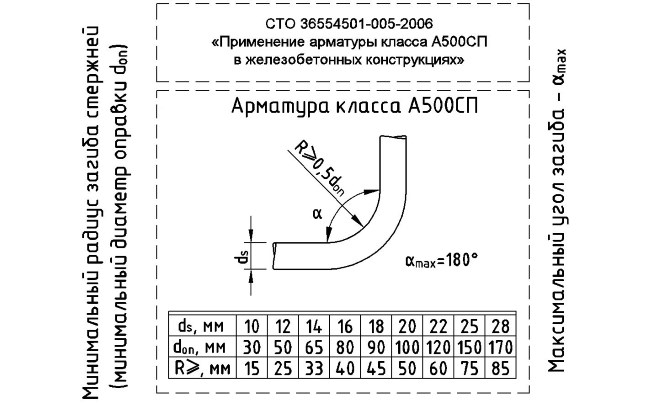
To obtain a reliable frame for the foundation, it should be done only mechanically, avoiding the formation of sharp corners at the bend. The rounding radius of the bars, which is formed at the bend, should have a value in the range of 10–15 diameters of the product itself.
Those who bend reinforcement with their own hands often make the following gross mistakes:
- make an incision or an incision at the bend to facilitate their work (such an incision, violating the structure of the metal bar, significantly weakens the structure of the frame);
- the place where it is necessary to bend is preheated with a blowtorch or by placing a rod in a fire.
After making an incision or heating the bar at home, it is usually bent using improvised means - a sledgehammer, a hammer, a piece of pipe, etc. Naturally, all such procedures lead to weakening and destruction of the reinforcing structure. To preserve its strength characteristics, it is necessary to bend the elements of which it consists only in a cold state and without violating the integrity of their structure, unless this is additionally specified in the project documentation.
Devices for bending reinforcing bars
A lot of devices and simple machines that allow you to bend any reinforcement with your own hands have been invented. All such devices operate on a similar principle, and their differences lie in the design and technical specifications, the most significant of which is the largest diameter of the bent bar.
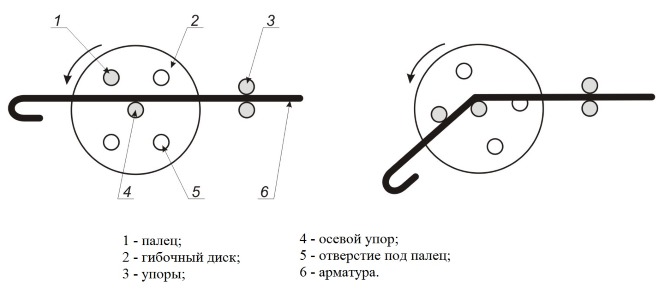
The reinforcement to be bent is fixed on such a machine between two rollers: central and thrust. The bending process itself is carried out due to the impact on the bar of the third roller, which is called: bending. Acting on the bar during the bending process (it can be performed both clockwise and in the opposite direction), the bending roller allows you to get the desired bending angle on the product. The thrust roller or shaft performs a limiting function, thanks to which the reinforcement is deformed not along the entire length, but only in the place where it is required to form a bend.
To date, two categories of such machines are used:
- manually operated devices;
- mechanical models.
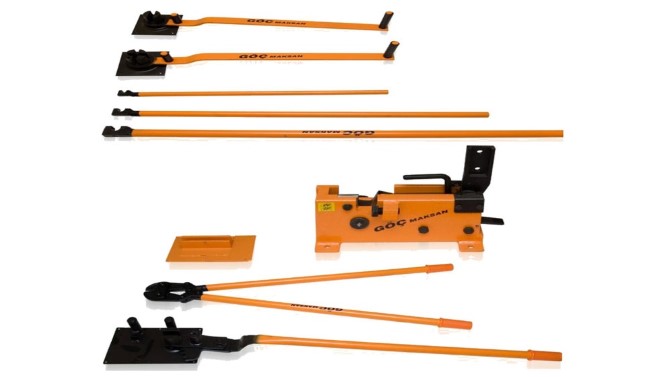
The design scheme of machine tools equipped with a mechanical drive is as follows. A disk is mounted on the shaft of the device, located vertically, on the surface of which the central and bending fingers are fixed. The roller, against which the reinforcing bar rests during the bending process, is fixed on the machine stand. The reinforcement using such a machine is bent according to the following scheme: the bar is placed between the central and bending fingers; when the disk rotates in a horizontal plane, the bar rests against the thrust roller and, under the influence of the bending finger, begins to bend around the central roller. The bending finger during the bending process moves along the outer side of the formed bend.
The machines, the design of which is described above, may differ from each other in their power and productivity, and according to their purpose, they are divided into three main categories:
- models for bending light reinforcement with a diameter of 3–20 mm;
- devices for working with heavy fittings (20–40 mm);
- models for bending extra-heavy reinforcing bars (40–90 mm).
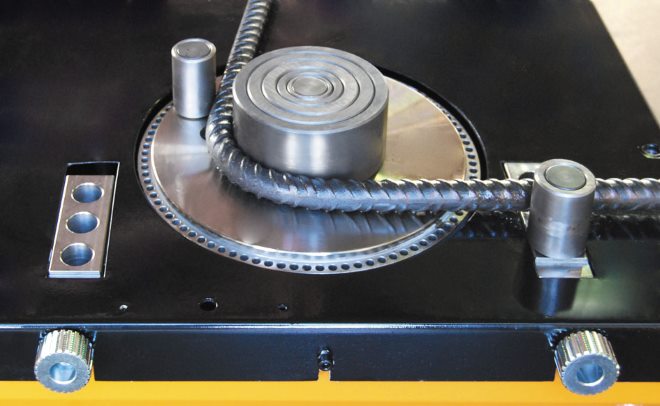
On machines belonging to the latter category, several reinforcing bars can be bent at the same time. On the modern market You can also find universal equipment, the technical capabilities of which allow you to bend metal bars in the diameter range of 3–90 mm. If desired, you can find a device with a hydraulic drive, with which complex reinforcing structures with variable bending angles are obtained, and even a ring is formed from a metal bar.
The use of such equipment allows you to make very high-quality bends, the angle of which can reach up to 180 degrees. The surfaces of blanks that have been bent on such equipment do not have folds or breaks, and there is no metal stress in their internal structure.
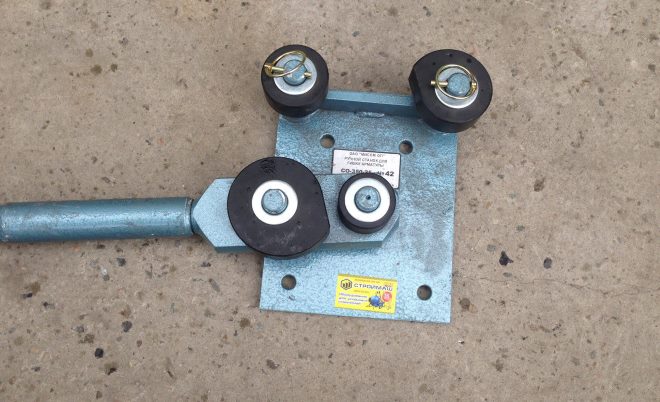
In a fairly large assortment, manual ones are also on the market, among which there are both portable and larger models. To bend reinforcement at home, you can purchase both a specialized manual fixture and a pipe bender. Such simple devices that allow you to perform various bends of reinforcing bars, the diameter of which does not exceed 14 mm, are mounted on the surface of a desktop or workbench. This option is quite suitable for equipping a home workshop, but if you need to perform large amounts of work on bending reinforcement, it is better to purchase a more serious machine.
The choice of equipment with which the reinforcement can be bent at home is mainly influenced by two factors: the diameter of the bars and the amount of work that you need to do. When bending, various parts of the reinforcing bar are subjected to loads of different directions: the outer surface of the bend is in tension, the inner surface is in compression. Such loads, if the machine is selected and adjusted incorrectly, can lead not only to the appearance of defects on the surface of the bar (kinks and folds), but also to its destruction. That is why it is necessary to choose a bending machine taking into account all the characteristics of the reinforcement that will be processed on it, and the parameters of the formed bends. Proper machine setup also has great importance to perform high-quality bending of reinforcement.
How to make a fixture for bending reinforcement with your own hands
Focusing on the drawings of serial bending machines, as well as on numerous videos on the Internet, you can make such a device with your own hands. You simply cannot do without such a device if you are going to make a reliable reinforcing frame to strengthen the foundation of your future home and buildings for other purposes.
![]()
The elements of a home-made machine for bending reinforcement are a metal frame, to the surface of which a stop pin is welded (you can use a regular corner), and a turntable made of metal, controlled by a lever (the central and bending pins are fixed on its surface). The choice of dimensions of such a fixture, as well as the distance between its elements, is influenced by the diameter of the bars that you are going to bend on it. You can attach this device either to the surface of the workbench using bolted connections, or to the floor of the workshop, but for this the machine must be equipped with legs.
The easiest ways to bend reinforcing bars
When reinforcing the foundation of small buildings, it is not always advisable to make special devices that allow bending reinforcement for it. In cases where the future structure, the foundation of which you are going to reinforce, will not exert serious loads on the base, you can do without bending devices.
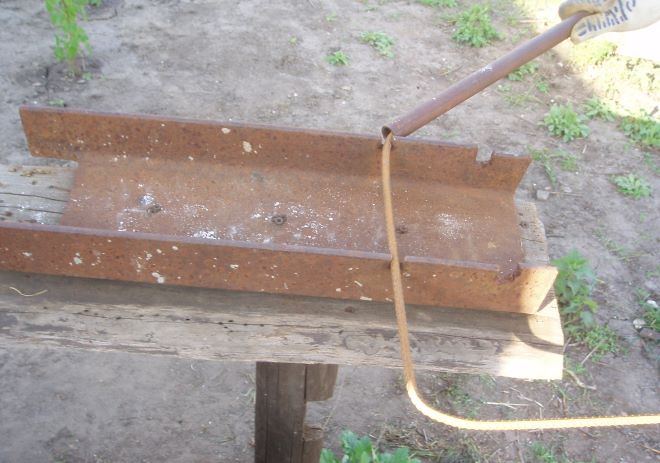
Metal bars, the diameter of which does not exceed 8 mm, can be bent with your own hands, this is not particularly difficult. True, it is not necessary to count on a high-quality bend in such cases. A more successful bend is obtained using two pipes, one of which acts as a lever, and the second as a thrust element. The pipe, which acts as a thrust element, can be clamped in a vice, buried or even concreted in the ground. You can learn how to bend any reinforcement without special devices from numerous videos on the Internet.
Almost no construction is complete without concrete work, and where there is concrete, there is reinforcement. Build the foundation, pour the ceiling,. All these works involve the use of reinforcement, with the help of which reinforced concrete structures are reinforced.
For beginner developers, the question often arises: how to properly bend the reinforcement so that it does not lose its strength characteristics.
If a bar with a diameter of 6-8 mm can be bent “on the knee”, then it is difficult to bend reinforcement with a larger diameter by hand. And most importantly - the quality of such a product will be below any criticism.
It is also impossible to resort to such "folk methods" of bending reinforcement as:
- Sawing with a "grinder" of the place of bending of the reinforcement.
- Heating the bending point of the reinforcement with an open flame, for example, in a fire or a blowtorch.
These methods, due to the mechanical and heat treatment of the metal, lead to a decrease in its strength characteristics at the bend. This can subsequently lead to the destruction of the reinforcement under the action of loads.
Therefore (if there are no other instructions for the project), the reinforcement must be bent "cold", while bending the rod at an acute angle is not allowed.
Reinforcement should be bent under a certain radius of curvature, which depends on its diameter.
For bending reinforcement, machines with a mechanical or manual drive are used. Due to the high cost, machine tools with a mechanical drive are not widely used among self-builders.
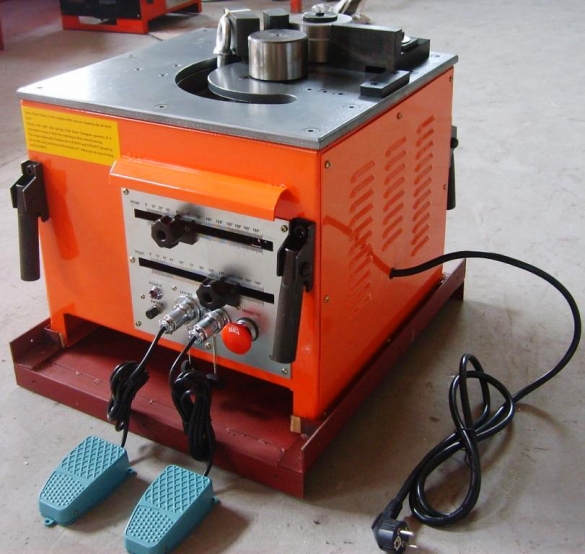
The price of branded manual benders also bites.

Therefore, FORUMHOUSE users prefer home-made products to purchased products. As practice shows, to make such a bending machine is within your power and yourself. In the course are cuttings of water pipes, channels, corners, bolts, cuttings of rolled metal and other "unnecessary trash", which, for sure, can be found in the bins of any home craftsman. The cost of such products ranges from 50 to 500 rubles, while the cost of an armature bender bought in a store can be 3-5 and 10 thousand rubles. The benefit is obvious. So let's roll up our sleeves and get to work.
How to make a bender yourself
The easiest and most affordable way to bend rebar of small diameter (no more than 6-8 mm) is to drive three pieces of thick rebar into a log. Moreover, two pieces are driven in along one line, and the third is driven in between them, indented from the center line by the thickness of the reinforcement that is supposed to be bent.
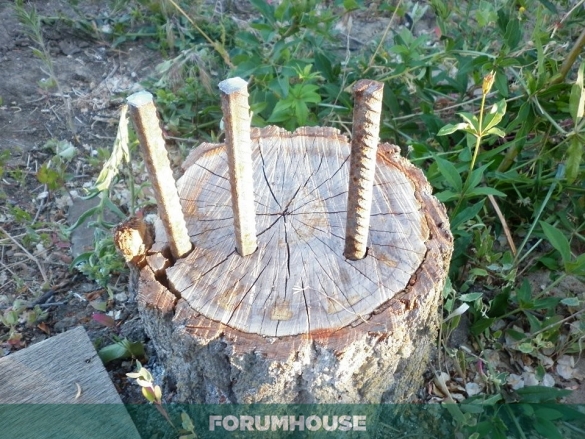
Another method is to attach / weld two corners with a bottom stop to the corner of the change house / pole, and bend the reinforcement between them.
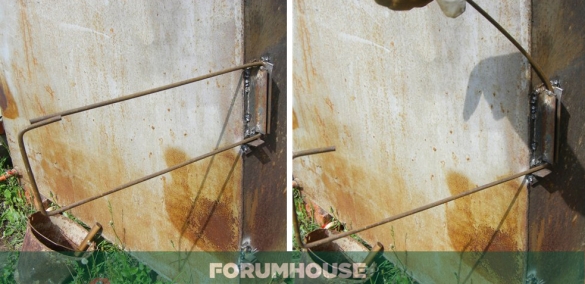
Or weld bolts to the fence post.
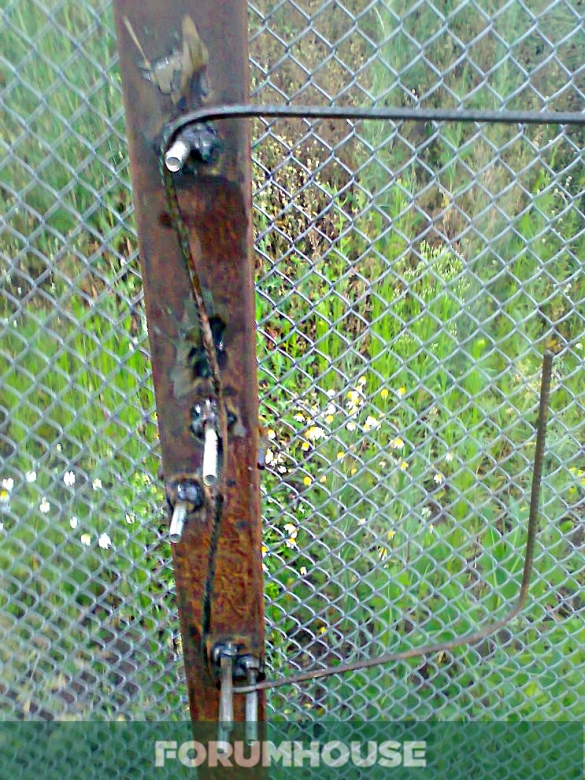
Despite the simplicity of these devices, they are not very convenient to work with, and they are best suited for the manufacture of U-shaped products, clamps and frames.
![]()
Therefore, the further development of the device is the manufacture of a full-fledged rebar bender operating in a horizontal plane.
The principle of operation of such a bender is as follows: a reinforcement bar is fixed between a thrust element (for example, a corner) and a central fixed metal pin. Next, we install a swivel assembly, which is equipped with a bending pin and a long lever (for example, a pipe).

When turning the bending unit, due to the force that occurs on the lever, the reinforcing bar is bent around the central metal pin to the required angle.

On such a machine, it is possible to manually bend rebar up to 14 mm in diameter, and when the structure is strengthened and a long lever (about 2 meters) is installed, rebar with a diameter of 16 mm will “submit” to you.
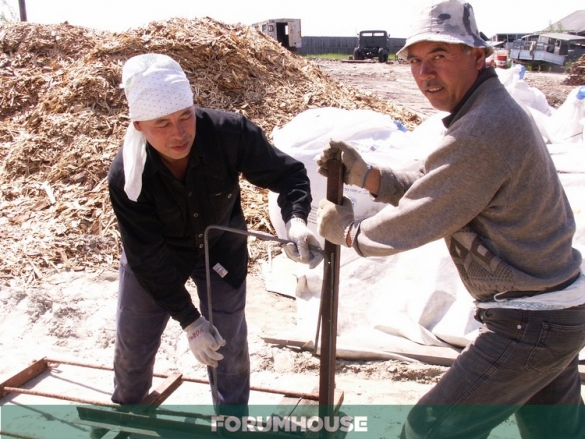
It takes a couple of hours to independently manufacture a mechanism that works according to this principle. Any builder who has ever worked on such a device will not return to bending reinforcement, holding it in a vice.
Here is one of the options for making such an armature bender according to the "recipe" of a forum member with a nickname Konstantin Ya.:

Konstantin Ya. FORUMHOUSE User
The bed is the 12th or 14th channel 1 meter long. We weld the channel to two supports ( metal pipes) driven into the ground. To stop the reinforcement, we weld two corners to the upper shelf of the channel. The lever is two pipes welded at an angle of 90 degrees. An axis passes through the vertical pipe, we put an extension 1.2 meters long on the horizontal pipe. This increases the force on the lever. We weld a corner on top of the lever, due to which the end of the reinforcement clings when it is bent. The corner should be flush with the upper shelf of the channel.
The forum member made the axle from a metal rod with a diameter of 30 mm. The lower part is turned into a square. This will prevent the axle from spinning or falling out. the bottom hole in the channel is also cut into a square. The upper end of the axis protrudes above the upper shelf of the channel. Around it, the reinforcement is bent.
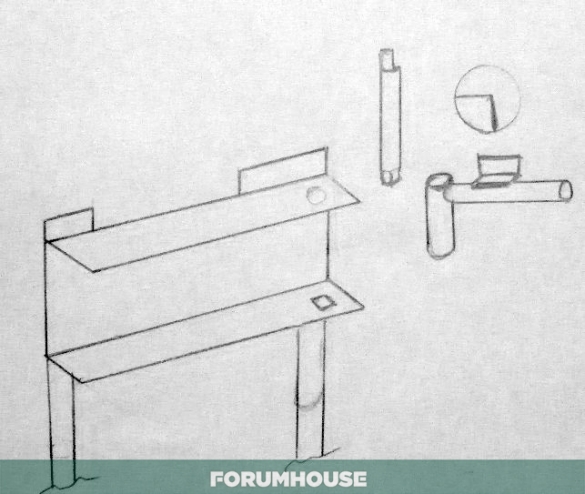

Konstantin Ya. FORUMHOUSE User
For the manufacture of the armature bender, for everything about everything, together with welding work, I spent 3 hours. I have already bent 3 tons of reinforcement on it. Calmly, alone, I bend reinforcement with a diameter of 14 mm. I am completely satisfied with the device, because. before its manufacture, he broke a good powerful vise - he bent reinforcement with a diameter of 12 mm on them, putting a pipe on it.

Vincenzo FORUMHOUSE User
My "unit" is somewhat simpler. The bed is a channel number 10-12. For the manufacture of "legs" I took reinforcement with a diameter of 20 mm. Corners - 50x4 in size. The "twelfth" fittings bent without problems.
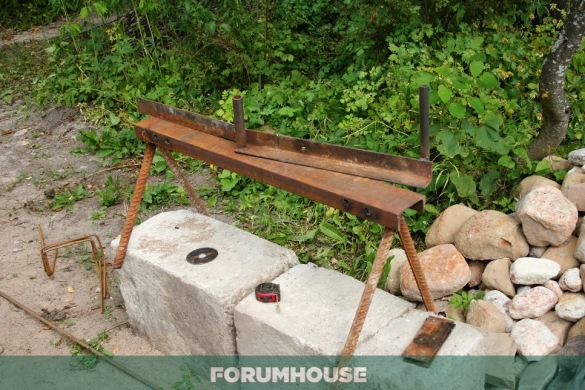
Considering the homemade products of the members of the forum, we can say that the reinforcement bender based on the corners has become the most widespread.
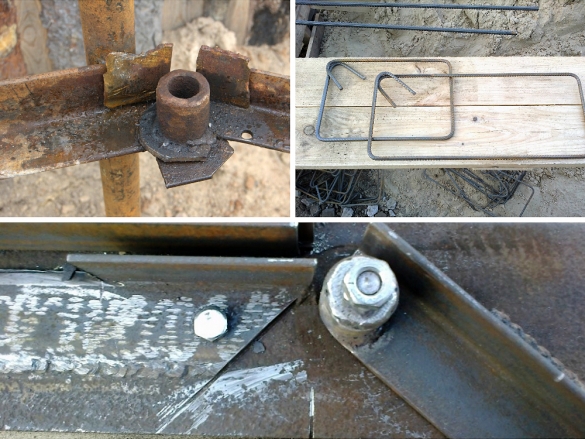
Such a device captivates with the simplicity of its manufacture, the availability of materials and low cost.

Such an armature bender can be made even without a welding machine, by doing with connections on bolts and nuts. But the presence of a welding machine significantly expands the possibilities of manufacturing an armature bender.

i-v FORUMHOUSE User
During the construction, I had a question, how to bend the reinforcement. Having studied the forum, I chose the simplest option - from two corners connected by a bolt. Because I needed to bend reinforcement no more than 8 mm in diameter, so I did not strengthen the structure. I welded a piece of pipe with a diameter of 20 mm to one corner. The corners were connected with an M10 bolt. I screwed nuts on it, then fixed the structure on an impromptu bed - a piece of thick plywood. It took 1.5 hours to make. Exactly the same amount of time was spent on the manufacture of frames measuring 150x750 mm in the amount of 90 pcs.
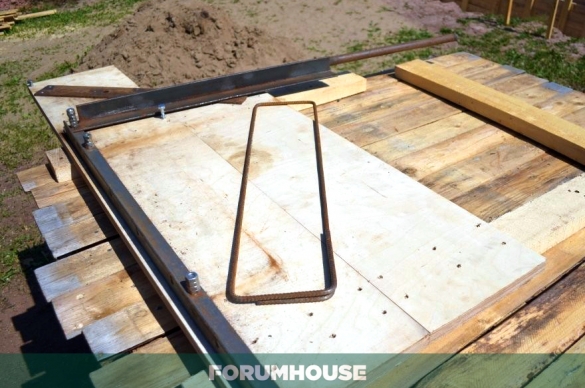
Despite the popularity of this design of the armature bender, the members of the forum go further along the path of modernization and improvement of the mechanism. Of particular interest is the armature bender made max68.2011.
Channel No. 10 is used as the basis, because it is convenient to fix it on a piece of timber. You will also need bearings, corners 25x25 mm 50 mm long, which are welded to the side of the channel. 2 holes are drilled on the side, thread M10x1.5 is cut (for thin fittings).

The axes of the armature bender are M16x2 bolts. One bolt is welded to the channel. We weld the second bolt to the earring (swivel unit), which is used as a spring from the Gazelle. The lever handle is a pipe with a diameter of 34 mm and a length of 300 mm. To increase the force on the lever, an extension can be put on a short pipe - a long pipe of a larger (put on outside) or smaller (inserted inside) diameter.
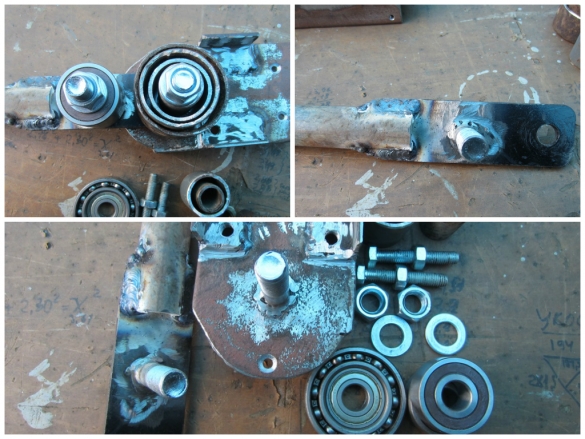
The use of a bearing in the bending unit allows the reinforcement to slide along the run-in. In the device itself, the armature is rigid. This increases the accuracy of manufacturing products.
It is worth focusing on the moment, for which the armature bender needs a set of bushings of different diameters 4 cm long.
According to SP 52-101-2003 "Concrete and reinforced concrete structures without prestressing reinforcement", when the reinforcement is bent, the minimum diameter of the bend of an individual bar must be such as to avoid the destruction or splitting of concrete inside the bend of the reinforcing bar and its destruction at the bend. Hence - the minimum diameter of the mandrel when bending the reinforcement depends on the diameter of the rod. For clarity, all values are summarized in the following table:
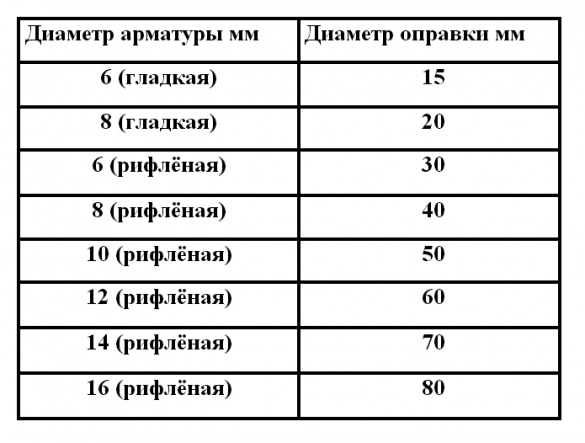
Thanks to a set of bushings, it is possible to flexibly select the bending radius of the reinforcement depending on its diameter.
 FORUMHOUSE User
FORUMHOUSE User
In my practice, I can say that I additionally “throw” on each bend from 5 mm. It depends on the diameter of the reinforcement. For example: you need to make a frame 50x20x4 (ears) from the “tens” reinforcement, add up: 4.5 + 50.5 + 20.5 + 50.5 + 20.5 + 4.5. The total length of the bar is obtained = 151 cm.
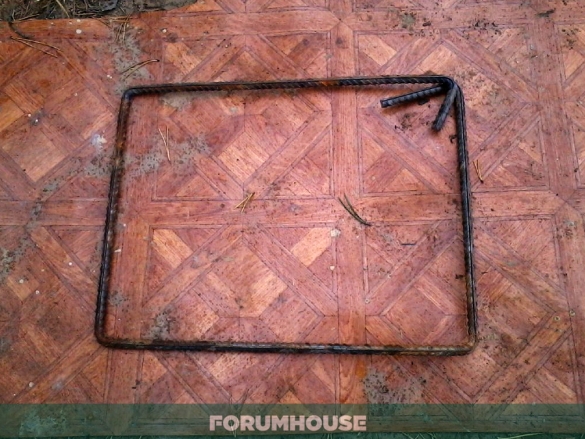
And at the end of the material, we will tell you about another “secret” of the members of the forum, which is used when bending reinforcement. It is necessary to fix the armature bender on a long wooden table and mark it in advance by screwing in the screws and marking with a marker the values \u200b\u200bthat correspond to the mounting size of the rotation of the rod in the bending unit. Thus, you can save yourself from the need to use a tape measure every time, measuring the required length of the reinforcement.
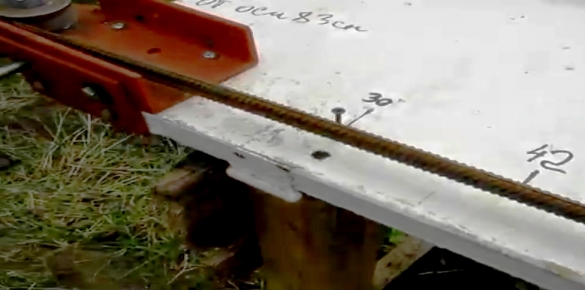
Almost no construction is complete without concrete work, and where there is concrete, there is reinforcement. Build a foundation, pour the floor, mount an armored belt in an aerated concrete house. All these works involve the use of reinforcement, with the help of which reinforced concrete structures are reinforced.
For beginner developers, the question often arises: how to properly bend the reinforcement so that it does not lose its strength characteristics.
If a bar with a diameter of 6-8 mm can be bent “on the knee”, then it is difficult to bend reinforcement with a larger diameter by hand. And most importantly - the quality of such a product will be below any criticism.
It is also impossible to resort to such "folk methods" of bending reinforcement as:
- Sawing with a "grinder" of the place of bending of the reinforcement.
- Heating the bending point of the reinforcement with an open flame, for example, in a fire or a blowtorch.
These methods, due to the mechanical and heat treatment of the metal, lead to a decrease in its strength characteristics at the bend. This can subsequently lead to the destruction of the reinforcement under the action of loads.
Therefore (if there are no other instructions for the project), the reinforcement must be bent "cold", while bending the rod at an acute angle is not allowed.
Reinforcement should be bent under a certain radius of curvature, which depends on its diameter.
For bending reinforcement, machines with a mechanical or manual drive are used. Due to the high cost, machine tools with a mechanical drive are not widely used among self-builders.
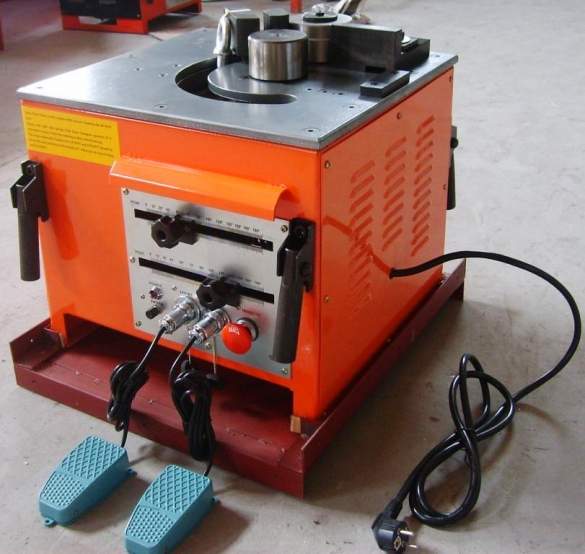
The price of branded manual benders also bites.
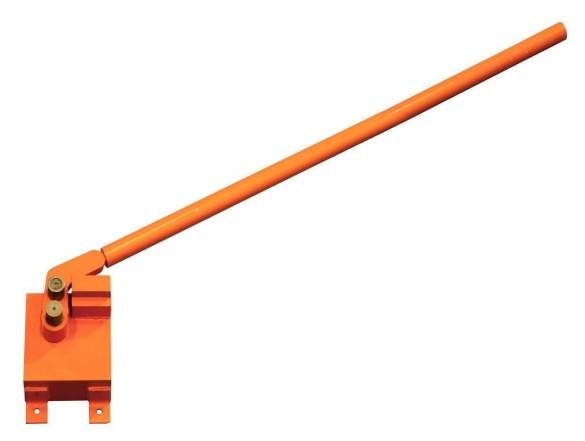
Therefore, FORUMHOUSE users prefer home-made products to purchased products. As practice shows, to make such a bending machine is within your power and yourself. In the course are cuttings of water pipes, channels, corners, bolts, cuttings of rolled metal and other "unnecessary trash", which, for sure, can be found in the bins of any home craftsman. The cost of such products ranges from 50 to 500 rubles, while the cost of an armature bender bought in a store can be 3-5 and 10 thousand rubles. The benefit is obvious. So let's roll up our sleeves and get to work.
How to make a bender yourself
The easiest and most affordable way to bend rebar of small diameter (no more than 6-8 mm) is to drive three pieces of thick rebar into a log. Moreover, two pieces are driven in along one line, and the third is driven in between them, indented from the center line by the thickness of the reinforcement that is supposed to be bent.
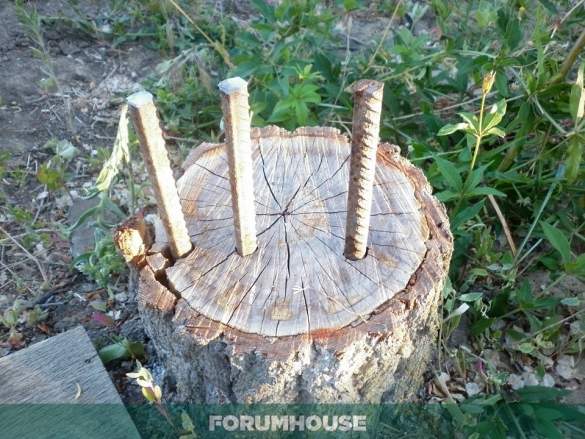
Another method is to attach / weld two corners with a bottom stop to the corner of the change house / pole, and bend the reinforcement between them.
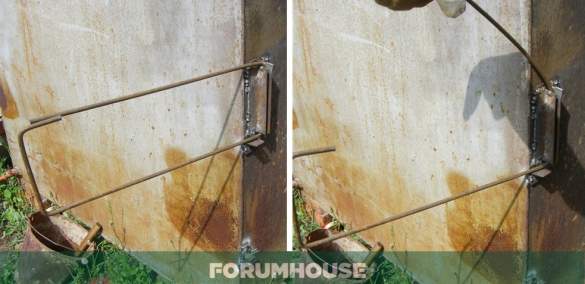
Or weld bolts to the fence post.
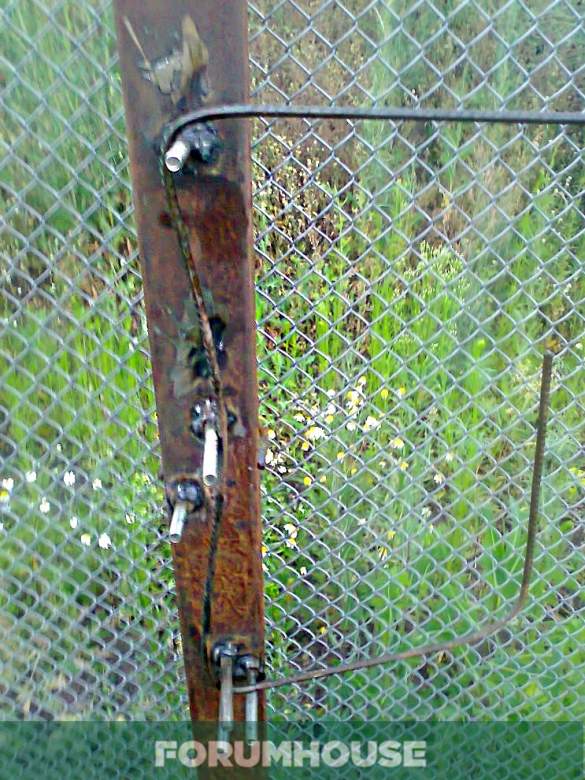
Despite the simplicity of these devices, they are not very convenient to work with, and they are best suited for the manufacture of U-shaped products, clamps and frames.
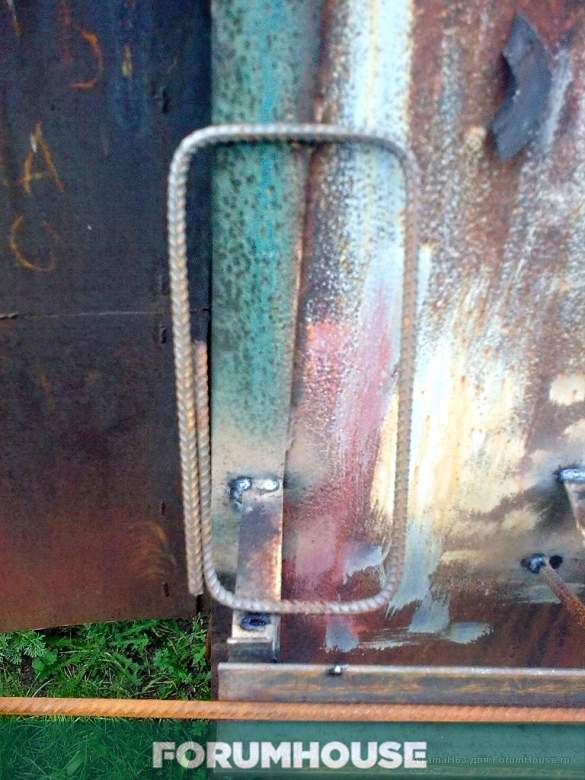
Therefore, the further development of the device is the manufacture of a full-fledged rebar bender operating in a horizontal plane.
The principle of operation of such a bender is as follows: a reinforcement bar is fixed between a thrust element (for example, a corner) and a central fixed metal pin. Next, we install a swivel assembly, which is equipped with a bending pin and a long lever (for example, a pipe).
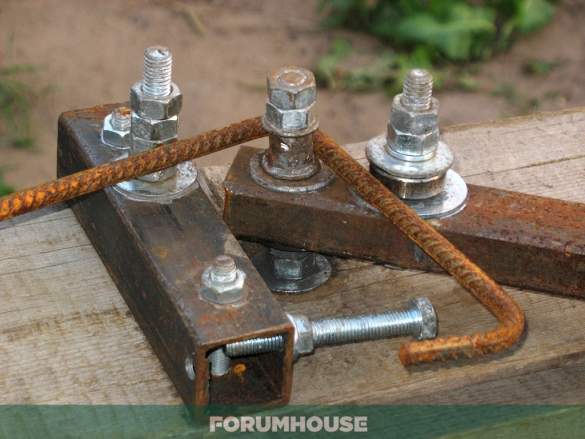
When turning the bending unit, due to the force that occurs on the lever, the reinforcing bar is bent around the central metal pin to the required angle.
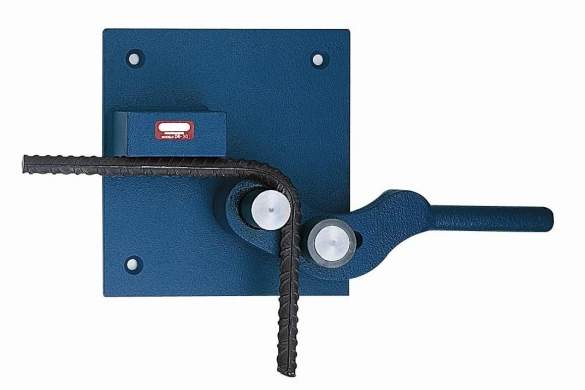
On such a machine, it is possible to manually bend rebar up to 14 mm in diameter, and when the structure is strengthened and a long lever (about 2 meters) is installed, rebar with a diameter of 16 mm will “submit” to you.
![]()
It takes a couple of hours to independently manufacture a mechanism that works according to this principle. Any builder who has ever worked on such a device will not return to bending reinforcement, holding it in a vice.
Here is one of the options for making such an armature bender according to the "recipe" of a forum member with the nickname Konstantin Ya .:
The bed is the 12th or 14th channel 1 meter long. We weld the channel to two supports (metal pipes) driven into the ground. To stop the reinforcement, we weld two corners to the upper shelf of the channel. The lever is two pipes welded at an angle of 90 degrees. An axis passes through the vertical pipe, we put an extension 1.2 meters long on the horizontal pipe. This increases the force on the lever. We weld a corner on top of the lever, due to which the end of the reinforcement clings when it is bent. The corner should be flush with the upper shelf of the channel.
The forum member made the axle from a metal rod with a diameter of 30 mm. The lower part is turned into a square. This will prevent the axle from spinning or falling out. the bottom hole in the channel is also cut into a square. The upper end of the axis protrudes above the upper shelf of the channel. Around it, the reinforcement is bent.
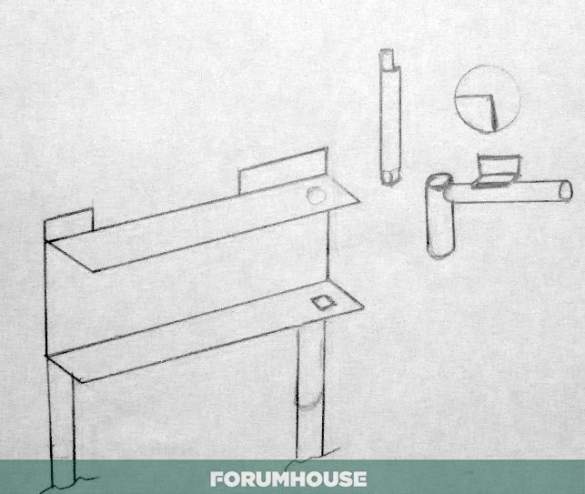
For the manufacture of the armature bender, for everything about everything, together with welding work, I spent 3 hours. I have already bent 3 tons of reinforcement on it. Calmly, alone, I bend reinforcement with a diameter of 14 mm. I am completely satisfied with the device, because. before its manufacture, he broke a good powerful vise - he bent reinforcement with a diameter of 12 mm on them, putting a pipe on it.
My "unit" is somewhat simpler. The bed is a channel number 10-12. For the manufacture of "legs" I took reinforcement with a diameter of 20 mm. Corners - 50x4 in size. The "twelfth" fittings bent without problems.
![]()
Considering the homemade products of the members of the forum, we can say that the reinforcement bender based on the corners has become the most widespread.

Such a device captivates with the simplicity of its manufacture, the availability of materials and low cost.

Such an armature bender can be made even without a welding machine, by doing with connections on bolts and nuts. But the presence of a welding machine significantly expands the possibilities of manufacturing an armature bender.
During the construction, I had a question, how to bend the reinforcement. Having studied the forum, I chose the simplest option - from two corners connected by a bolt. Because I needed to bend reinforcement no more than 8 mm in diameter, so I did not strengthen the structure. I welded a piece of pipe with a diameter of 20 mm to one corner. The corners were connected with an M10 bolt. I screwed nuts on it, then fixed the structure on an impromptu bed - a piece of thick plywood. It took 1.5 hours to make. Exactly the same amount of time was spent on the manufacture of frames measuring 150x750 mm in the amount of 90 pcs.

Despite the popularity of this design of the armature bender, the members of the forum go further along the path of modernization and improvement of the mechanism. Of particular interest is the armature bender made by max68.2011.
Channel No. 10 is used as the basis, because it is convenient to fix it on a piece of timber. You will also need bearings, corners 25x25 mm 50 mm long, which are welded to the side of the channel. 2 holes are drilled on the side, thread M10x1.5 is cut (for thin fittings).
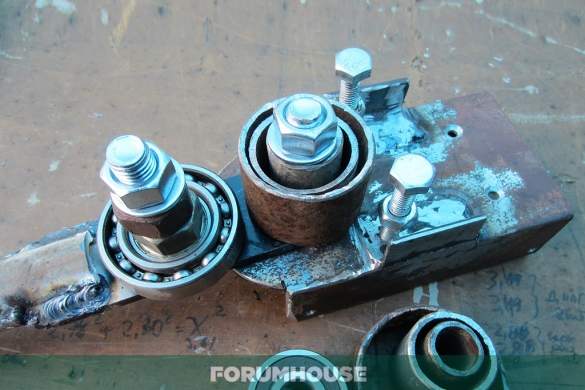
The axes of the armature bender are M16x2 bolts. One bolt is welded to the channel. We weld the second bolt to the earring (swivel unit), which is used as a spring from the Gazelle. The lever handle is a pipe with a diameter of 34 mm and a length of 300 mm. To increase the force on the lever, an extension can be put on a short pipe - a long pipe of a larger (put on outside) or smaller (inserted inside) diameter.
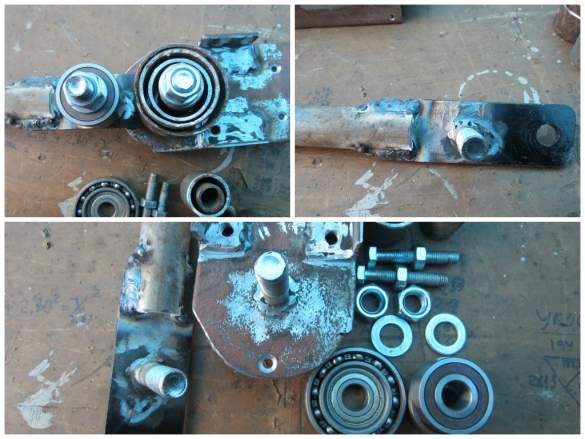
The use of a bearing in the bending unit allows the reinforcement to slide along the run-in. In the device itself, the armature is rigid. This increases the accuracy of manufacturing products.
It is worth focusing on the moment, for which the armature bender needs a set of bushings of different diameters 4 cm long.
According to SP 52-101-2003 "Concrete and reinforced concrete structures without prestressing reinforcement", when the reinforcement is bent, the minimum diameter of the bend of an individual bar must be such as to avoid the destruction or splitting of concrete inside the bend of the reinforcing bar and its destruction at the bend. Hence - the minimum diameter of the mandrel when bending the reinforcement depends on the diameter of the rod. For clarity, all values are summarized in the following table:

Thanks to a set of bushings, it is possible to flexibly select the bending radius of the reinforcement depending on its diameter.
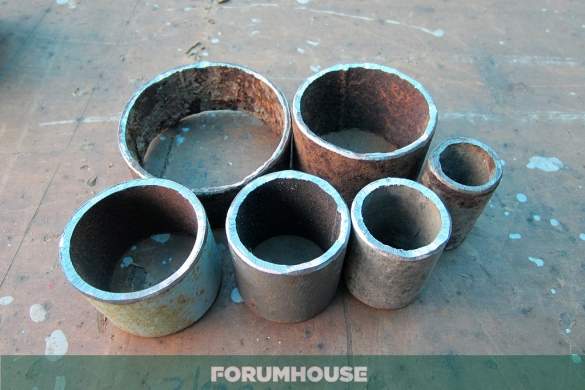
Over time, the max68.2011 armature bender has undergone changes. Now he is appearance no different from industrial products.
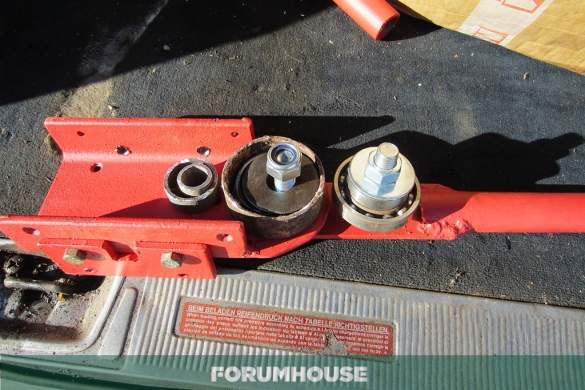
Also, many members of the forum are interested in the question: how to calculate the length of the reinforcement bar in the manufacture of frames. After all, a simple addition of values, for example, if the frame should turn out to be 50x20 + 2 lugs of 40 mm each, then purely theoretically, the length of the rod should be equal to 50 + 50 + 20 + 20 + 4 + 4 \u003d 148 cm. But, taking into account the bend radii, this figure is most likely incorrect. How to be?
In my practice, I can say that I additionally “throw” on each bend from 5 mm. It depends on the diameter of the reinforcement. For example: you need to make a frame 50x20x4 (ears) from the “tens” reinforcement, add up: 4.5 + 50.5 + 20.5 + 50.5 + 20.5 + 4.5. The total length of the bar is obtained = 151 cm.
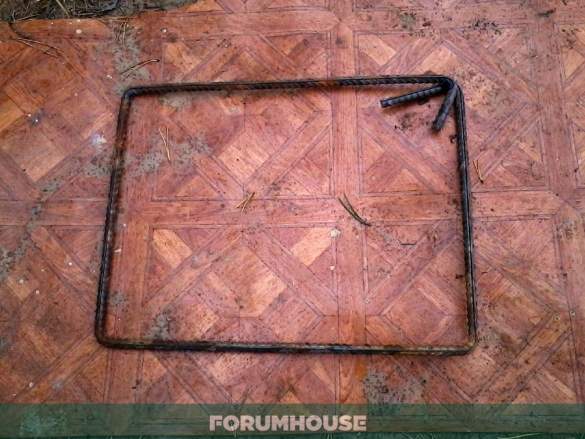
And at the end of the material, we will tell you about another “secret” of the members of the forum, which is used when bending reinforcement. It is necessary to fix the armature bender on a long wooden table and mark it in advance by screwing in the screws and marking with a marker the values \u200b\u200bthat correspond to the mounting size of the rotation of the rod in the bending unit. Thus, you can save yourself from the need to use a tape measure every time, measuring the required length of the reinforcement.

After reading the topics How to bend rebar? and armature bender with your own hands in 1.5 hours, you will get acquainted with various options self-manufacturing of this device. We also offer to find out the answer to the question: how to properly reinforce the foundation in the corners. FORUMHOUSE also recommends learning all the secrets of welding and reading an article about the features of cold forging. And this video will help you understand how to properly carry out reinforcing work.








